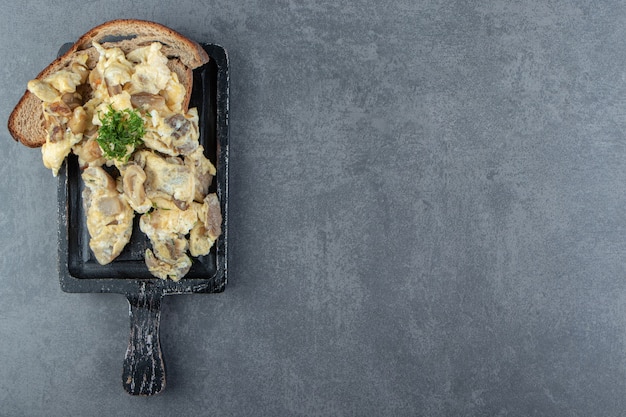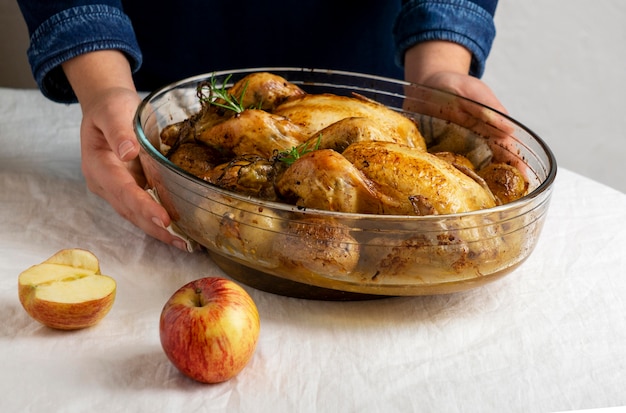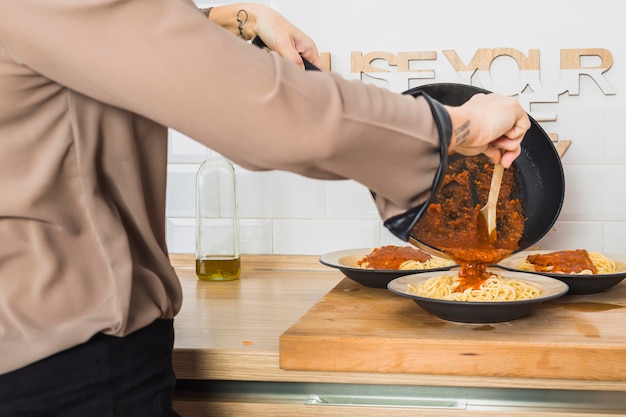Let’s be honest: cooking chicken can be a bit daunting, especially when it comes to getting that perfect texture and making sure it’s cooked through. But fear not! Cubed chicken is a culinary chameleon, adaptable to countless recipes, and mastering it is a skill every home cook should have in their arsenal.
Today, we're going to dive into the ins and outs of cooking cubed chicken on the stovetop. I’ll share my tried-and-true techniques and tips, so you can consistently create juicy, flavorful chicken for any dish. Think stir-fries, hearty stews, pasta dishes, or even a simple chicken salad. The possibilities are endless, and once you master this, you’ll be whipping up delicious chicken meals in no time.
So grab your trusty frying pan, a splash of oil, and a little bit of culinary confidence – we're about to embark on a journey to perfect stovetop chicken!
Part 1: Prepping Your Chicken

The key to delicious chicken lies in proper preparation. It's like building a solid foundation for a beautiful house – if the base isn't strong, the final result won't be as impressive. So let's get those chicken cubes prepped and ready to shine!
1. Choosing Your Chicken: A Matter of Taste
When it comes to chicken, I’m a firm believer in bone-in, skin-on chicken thighs. Why? They’re packed with flavour and moisture, creating a tender, succulent bite. However, if boneless, skinless chicken breasts are what you have on hand, no worries! We can still work with them and create a fantastic dish.
If you’re using bone-in chicken, the first step is to remove those bones. You can ask your butcher to do this for you, saving you a little time and effort. But if you're feeling a bit more adventurous, tackling this step yourself can be quite therapeutic. It’s a great way to connect with the food you're cooking!
2. Cubing Your Chicken: Precision Isn’t Required
Now, here comes the fun part – cubing your chicken! I prefer cubes that are about 1-1.5 inches in size. This ensures even cooking and prevents those dry, overcooked pieces that can happen with larger cuts. Remember, it’s not about perfect, symmetrical cubes – just roughly even-sized pieces will do the trick.
3. Seasoning with Love: A Flavorful Symphony
Once your chicken is cubed, it’s time to give it a flavour boost. I'm a firm believer in keeping seasoning simple. A good sprinkle of salt and pepper goes a long way, bringing out the natural flavour of the chicken.
But if you’re feeling a little adventurous, don’t be afraid to play around with other spices and herbs. A touch of paprika, garlic powder, onion powder, or even a dash of cayenne pepper can create a fantastic flavour profile.
I like to match my seasonings to the dish I'm making. For a Mediterranean twist, I might add oregano, thyme, and a squeeze of lemon juice. A spicy kick can be achieved with a touch of chili flakes. The beauty of cooking is in the endless possibilities – experiment and have fun!
Part 2: Mastering the Stovetop: Equipment and Techniques

Now that your chicken is prepped and ready to go, it’s time to hit the stovetop! This is where the magic happens, and a little bit of know-how can make all the difference in achieving those perfectly cooked chicken cubes.
1. Choose Your Pan Wisely: A Sturdy Foundation for Success
A good quality frying pan is essential for cooking cubed chicken. I'm a huge fan of cast iron pans – they distribute heat beautifully and create that coveted crispy sear, adding a delightful texture and flavour. But don't worry if you don’t have one, a non-stick pan will do just fine.
No matter what kind of pan you choose, make sure it’s large enough to accommodate all your chicken cubes without overcrowding the pan. Overcrowding can lead to steam building up, preventing the chicken from browning properly, and resulting in a less-than-ideal, mushy texture.
2. The Art of Oil: A Lubricant for Deliciousness
Just like with anything else in life, a little oil can go a long way when cooking. For a good sear on your chicken, I recommend using a neutral oil with a high smoke point, such as vegetable oil or canola oil.
Don’t be afraid to use enough oil to coat the bottom of the pan. You want to create a thin layer that will allow the chicken to brown beautifully. But remember, too much oil can make your chicken greasy, so aim for a balanced approach.
3. Don't Overcrowd the Pan: Space is the Key
I cannot emphasize this enough: Don’t overcrowd the pan! Overcrowding leads to steam instead of browning. If you have a large batch of chicken, cook it in batches to ensure even browning on all sides.
Remember that time I tried to cook a whole batch of chicken in one pan? It was a culinary disaster! The chicken ended up pale, steamed, and completely lacked that satisfying crispy exterior. So, learn from my mistakes, and cook those chicken cubes in batches – your taste buds will thank you.
Part 3: cooking time: A Guide to Perfection

Now for the moment of truth – how long do you actually cook those chicken cubes on the stovetop? The answer, as with most things in cooking, depends on a few factors.
1. Searing for Flavor: A Quick Bite of Delight
If you're simply looking to sear the chicken for flavour, you only need to cook it for a couple of minutes on each side, until it’s nicely browned. This is perfect for stir-fries, where you want to add the chicken towards the end of the cooking process. You’ll get a delicious sear and tender chicken in a flash.
2. Cooking for Tenderness: A Deeper Dive into Doneness
If you want the chicken to be fully cooked through, you’ll need to cook it for longer, around 5-7 minutes on each side, depending on the size of your cubes. The chicken should be cooked through and no longer pink.
To check for doneness, make a small cut into a few pieces. If the juices run clear, it’s cooked through. If they’re still pink, it needs a little more time on the stovetop.
3. Temperature Matters: Finding the Sweet Spot
The temperature of your pan also plays a crucial role in cooking time. A medium-high heat is ideal for browning the chicken cubes. If the heat is too low, the chicken will steam instead of brown, resulting in a pale and less flavorful chicken.
Remember, every stovetop is different, and the thickness of your chicken can also affect cooking time. It's always best to adjust your cooking time based on your own experience and the specific situation.
Part 4: chicken doneness: Ensuring Safety and Flavor
How do you know when your cubed chicken is actually cooked through and safe to eat? It’s a crucial question, and there are a few methods you can use to check for doneness.
1. The Cut Test: A Simple Visual Cue
My go-to method is the cut test. Simply make a small cut into a few pieces. If the juices run clear, the chicken is cooked through. If they’re still pink, it needs a little more time on the stovetop.
2. The Thermometer Test: Scientific Precision for Peace of Mind
For those who prefer a more precise approach, using a meat thermometer is a great way to ensure your chicken is cooked to perfection. The chicken should reach an internal temperature of 165 degrees Fahrenheit (74 degrees Celsius) for it to be safe to eat.
3. Trust Your Senses: A Multi-Sensory Approach
Don’t forget to use your senses! Your chicken should be a nice golden brown color, indicating that it has been cooked properly. Also, be sure to smell the chicken – it should have a cooked, not raw, aroma.
Part 5: cooking tips: Elevating Your Chicken Game
Now, let’s talk about a few tips that can help you cook those chicken cubes to absolute perfection.
1. Don't Overcrowd: Give Your Chicken Space to Breathe
Remember what I said about overcrowding? It's a key factor in achieving that crispy sear. Don't pile your chicken cubes on top of each other. Cook in batches if necessary, giving each piece enough room to brown evenly.
2. Flip It Like It’s Hot: Even Browning is Crucial
When you’re searing your chicken, flip those cubes frequently. This will help ensure that they brown evenly on all sides. No one wants a chicken with a burnt side and a pale, undercooked side.
3. Take Your Time: Patience is a Virtue in the Kitchen
Cooking is a journey, not a race. Take your time and let the chicken cook through properly. Don’t rush the process, or your chicken might end up dry and chewy. Give those chicken cubes the time they need to develop a delicious texture and flavor.
4. Season with Love: A Symphony of Flavors
As I mentioned before, seasoning is key. Don’t be afraid to experiment with different spices and herbs. A little bit of creativity can transform your chicken into a culinary masterpiece. But remember, a little goes a long way! Start with a pinch or two, and adjust according to your taste.
5. Rest Before Serving: A Moment of Relaxation for Maximum Flavor
Once the chicken is cooked, let it rest for a few minutes before serving. This will allow the juices to redistribute, resulting in a juicier, more flavorful dish. While you're waiting, you can prepare your sides or other components of your meal.
Part 6: What to Do with Your Chicken: A Culinary Canvas
Now that you’ve mastered the art of cooking cubed chicken on the stovetop, it’s time to put those skills to good use! Here are a few ideas for what to do with your perfectly cooked chicken.
1. Stir-fries: A Quick and Flavorful Meal
Stir-fries are a classic way to use cubed chicken. Simply toss it with your favourite vegetables and a flavorful sauce. I love to make a stir-fry with broccoli, carrots, bell peppers, and a savory soy sauce-based sauce. It’s a great way to get a healthy and satisfying meal on the table quickly.
2. Chicken Curry: A Creamy and Aromatic Delight
Cubed chicken is perfect for making a creamy and aromatic curry. My go-to recipe includes coconut milk, spices like turmeric and cumin, and a healthy dose of fresh cilantro. It's a comforting and flavorful dish that's perfect for a cozy evening meal.
3. Chicken Salad: A Versatile and Delicious Option
Cubed chicken is a delicious addition to any chicken salad. I love to mix it with mayonnaise, celery, grapes, and a sprinkle of walnuts. It's a perfect sandwich filling or salad base, and it’s a great way to use leftover chicken.
4. Chicken Soup: A Hearty and Comforting Classic
Cubed chicken is also great for making a hearty and comforting soup. Add it to your favourite soup base with vegetables like carrots, celery, and potatoes, and season with herbs and spices. It’s a classic dish that’s sure to warm you up on a cold day.
5. Chicken Pasta: A Simple and Flavorful Weeknight Meal
For a quick and easy pasta dish, simply toss your cooked chicken with your favourite pasta, sauce, and vegetables. I love to make a creamy chicken pasta with alfredo sauce, spinach, and mushrooms. It’s a simple dish that can be on the table in under 30 minutes.
Part 7: Variations: Expanding Your Chicken Horizons
Don’t be afraid to experiment and create your own variations. Here are a few ideas to get you started:
1. Spicy Chicken: A Kick of Heat
Add a touch of heat to your chicken by adding chili flakes, cayenne pepper, or other spices. You can adjust the amount of spice to your personal preference.
2. Mediterranean Chicken: A Taste of the Sun
Embrace the flavors of the Mediterranean by adding herbs like oregano, thyme, and rosemary. A squeeze of lemon juice adds a bright and tangy touch.
3. Asian-Inspired Chicken: A Fusion of Flavors
Incorporate soy sauce, ginger, and garlic for a delicious Asian-inspired flavor. This is a great base for stir-fries or other Asian-inspired dishes.
4. Lemon Herb Chicken: A Refreshing Twist
Brighten up your chicken with the zest and juice of lemon and fresh herbs like parsley and dill. It's a light and flavorful option that’s perfect for summer meals.
5. BBQ Chicken: A Smoky and Sweet Treat
Brush your chicken with your favourite bbq sauce for a sweet and smoky flavor. It’s a classic combination that’s always a crowd-pleaser.
Part 8: Storage: Keeping Your Chicken Fresh and Delicious
Once your chicken is cooked, it’s time to think about storage. Here are a few tips to help you keep your chicken fresh and delicious.
1. Cool It Down: A Crucial Step for Safety
Let your cooked chicken cool completely before storing it. This will help prevent bacteria growth. You can place it in a shallow container or on a plate in the refrigerator to speed up the cooling process.
2. Store It Properly: An Airtight Sanctuary
Store your cooked chicken in an airtight container in the refrigerator. It will last for 3-4 days. Make sure the container is airtight to prevent any other flavors from transferring to the chicken.
3. Freeze It: Extending the Life of Your Chicken
You can also freeze your cooked chicken for up to 3 months. Simply place it in a freezer-safe bag or container. Be sure to squeeze out as much air as possible from the bag to prevent freezer burn.
Part 9: FAQs
Let's answer some common questions about cooking cubed chicken on the stovetop.
1. What is the best way to prevent chicken from drying out?
The best way to prevent chicken from drying out is to cook it over medium-high heat, flip it frequently, and let it rest for a few minutes before serving. These techniques help to ensure that the chicken cooks evenly and retains its moisture.
2. Can I cook cubed chicken in the oven?
Yes, you can certainly cook cubed chicken in the oven. Simply preheat your oven to 400 degrees Fahrenheit (200 degrees Celsius). Place the chicken cubes on a baking sheet lined with parchment paper. Cook for 15-20 minutes, or until the chicken is cooked through.
3. How do I reheat leftover cubed chicken?
You can reheat leftover chicken in the microwave, on the stovetop, or in the oven. Just make sure it reaches an internal temperature of 165 degrees Fahrenheit (74 degrees Celsius) before serving.
4. Can I cook cubed chicken in a slow cooker?
Yes, you can cook cubed chicken in a slow cooker. Simply add it to your favourite slow cooker recipe and cook on low heat for 6-8 hours, or on high heat for 3-4 hours.
5. How do I know if chicken is spoiled?
If your chicken has a sour or off smell, or if it has a slimy texture, it’s spoiled and should be thrown away. It's always better to err on the side of caution when it comes to food safety.
There you have it! You’re now equipped with the knowledge and confidence to cook cubed chicken on the stovetop like a pro. Go forth and create culinary masterpieces, and remember, if you have any questions or need any more advice, don't hesitate to ask! Happy cooking!
Everyone is watching

Corn on the Cob: The Ultimate Guide to Perfectly Cooked Ears
Healthy MealsAh, corn on the cob. Just the name evokes images of sunny days, barbecues, and that sweet, juicy flavour that ...

Perfect Pork Roast Oven Cooking Time: A Guide to Delicious Results
Healthy MealsThere's something truly satisfying about a perfectly roasted pork. The aroma alone is enough to make your mout...

Ham Cooking Time: How Long to Bake, Smoke, or Boil a Delicious Ham
Healthy MealsAh, ham. It's a classic, isn't it? A real crowd-pleaser, especially around holidays. And when done right, it'...

Scallops: The Ultimate Guide to Perfect Cooking
Healthy MealsAh, scallops. Those delicate, sweet, and utterly delicious morsels of the sea. They hold a special place in my...

Spaghetti Squash: The Ultimate Guide to Cooking and Serving
Healthy MealsRemember that time you saw spaghetti squash at the supermarket, looking all bumpy and strange, and thought, "W...
